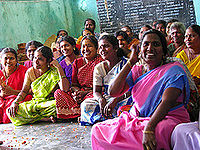Course:LIBR562 Group 5 Wiki Project
| Women and freedom of access to information in West Bengal, India. | |
|---|---|
 | |
| LIBR 562 | |
| Section: | 98B |
| Instructor: | Shirley Giggey |
| Email: | sgiggey@telus.net |
| Office: | |
| Office Hours: | |
| Class Schedule: | |
| Classroom: | |
| Important Course Pages | |
| Syllabus | |
| Lecture Notes | |
| Assignments | |
| Course Discussion | |
This wiki is being created as a group project for LIBR 562 International Issues and Innovations. The topic we have chosen is "Women and freedom of access to information in India".
Contributors
Leah Hopton, Shawn Roncin, Keshav Mukunda, Marty Rose
Introduction
Explanation of situation for women in India re: access to information (incl. what are obstacles for women?)[1]
India's Information Policy
Analysis of India's Information Policy (if such exists)
Types of Information
Information that women might need/want to access - i.e. small business information, health information, agriculture information
Initiatives
The main initiatives taking place to connect women with information in India are through Public Libraries, Women's Studies Centres, NGO's working on women's issues and State Commissions for Women in association with District Health Services.[2]
Village Resource Centres
The Indian Space Resource Organisation provide Village Resource Centres (VRCs) throughout India at agricultural universities, skill development institutes and hospitals.[3] These are permanent establishments designed to provide digital information to people through satellite transmissions that allow users to interact directly with information providers through audio and video. The services include information on agriculture, fishing, health care, computer literacy, vocational training as well as Women empowerment.[4] 275 VRCs have been organized in association with 40 different partner agencies, consisting of NGOs, Trusts and Government agencies. For instance the Grameen Granchar Society (GRASSO) and the NASSCOM Foundation jointly operate 10 VRCs in West Bengal.[5] Over 6500 programs have been delivered through VRCs to over 500,000 people in 16 or it's 28 states.[6]
Basanti Devi College
Basanti Devi College is a school for girls affliated with the University of Calcutta. It was established in 1959 with the goal of promoting "women empowerment". The students come to the school usually from rural environments and with little or no computer skills. The Basanti Devi College Library has been at the forefront of initiatives designed to make the students "empowered through access to information". The school library also runs an Earn While You Learn program that is designed to "expose them to the world of information by which they can be able to make themselves economically independent in their future life."[7]
Self Employed Women's Association
The Self Employed Women's Association (SEWA) is an organization that acts as a trade union for self-employed women workers in India. SEWA's goal is to give women workers self-reliance, so they can be "autonomous..., individually and collectively, both economically and in terms of their decision-making ability."[8] There are many services provided by SEWA or it's sister organizations that specifically address the information needs for women. One is the ICT School of Sewa (ICT @ Sewa) which focuses on "capacity building, livelihood generation and security and knowledge sharing." [9]
Possible Solutions
Future for women
what is the "prognosis" on the issue? Are things improving for women?
Resources
References
- ↑ test
- ↑ Bandyopadhyay, R. & Goswami, S. (2007) Health related services for women through public libraries in West Bengal, India. World Library and Information Congress: 73rd IFLA General Conference and Council. Retrieved from http://archive.ifla.org/IV/ifla73/papers/118-Bandyopadhyay_Goswami-en.pdf
- ↑ ISRO.org (2008) Village Resource Centres (VRCs). Retrived from http://www.isro.org/scripts/villageresourcecentres.aspx
- ↑ M S Swaminathan Foundation (2009) Proceedings of the Virtual Conference on celebrating women's contributions to safeguarding and strengthening ecological society. Jamsetji Tata National Virtual Academy (NVA): M S Swaminathan Research Foundation. Retrieved from http://www.mssrf.org/iec/pubfile/Virtual%20Congress_2009.pdf
- ↑ Grassoportal.com (n.d.) News Letter: Current Projects. Grameen Sanchar Society. Retrieved from http://www.grassoportal.com/News_Letter/NL_current_proj.htm
- ↑ India Space Resource Organisation (2007) Space technology enabled Village Resource Centre (VRC). Publication and Public Relations: Indian Space Research Organisation. Retrieved from http://www.isro.org/publications/pdf/VRCBrochure.pdf
- ↑ Chaudhuri, S.K. (2011). Realising the goal of women empowerment through access to information: Basanti Devi College as a Case Study. World Library and Information Congress: 77th IFLA General Conference and Council. Retrieved from http://conference.ifla.org/sites/default/files/files/papers/ifla77/150-chaudhuri-en.pdf
- ↑ SEWA.org (2009) About us: Introduction. Retrieved from http://www.sewa.org/About_Us.asp
- ↑ SEWAICT.org (n.d.) ICT @ SEWA. Retrieved from http://www.sewaict.org/ICT%20@%20SEWA.htm
- ↑ Bandyopadhyay, R., Goswami, S. & Nausheen, S. (2009) Women’s health literacy and health promotion: our initiatives in West Bengal, India. World Library and Information Conference: 75th IFLA General Conference and Council. Retrieved from http://archive.ifla.org/IV/ifla69/papers/600-Dasgupta.pdf